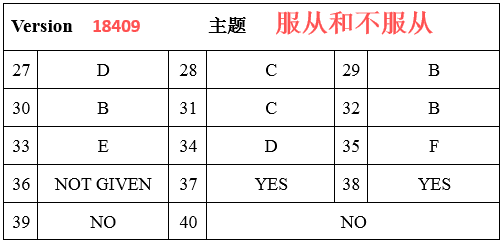很多考生在报考雅思之前,复习时间都非常紧迫。下面小编给大家带来了雅思阅读短期暴走冲刺方法,希望能够帮助到大家,下面小编就和大家分享,来欣赏一下吧
雅思阅读短期暴走冲刺方法
解题顺序和时间分配
在雅思阅读中,解题顺序是很关键的一步,很多考生及其容易忽略这一点,导致很多考生在考场上时间分配不合理,耽误了整个阅读考试的进程,不少考生在考场上的第三篇文章基本都是连蒙带猜做出来的,正确率非常之惨淡。所以,拿到一篇雅思阅读文章后:
第一步:看文章标题
很多文章我们在看完文章标题以后就能够结合常识对文章的内容进行合理预测。比如:let’s go bats 这篇文章,我们就能确定首先文章是在讲蝙蝠这种动物。而关于蝙蝠大家都知道的特点就是在夜晚活动和狩猎,喜欢生活在阴暗潮湿环境,知识储备好一点的学生可能还会联想到声波。所以,文章里自然讲的东西也不会偏离太远。其次,在文章里遇到的不认识的单词,可以往这个话题上靠拢,比如:sonar ,radar(声纳和雷达),就是跟蝙蝠的声波有关的概念。
第二步:看文章引言
雅思阅读有一些文章是有引言的,引言一般和标题正文的字体都不一样。基本有以下3个作用:a 文章内容简介 7-P89 b 文章背景介绍 8-P26 c 答案来源 8-P50
看引言能够帮考生在最短时间内了解文章的大概内容,减少阅读过程中的障碍
第三步:看题目
很多考生在拿到阅读文章后会习惯性地先粗略地看一遍文章或者文章段落的首末句,而这个时候一般收效甚微,因为会遇到单词困境,所以,比较推荐是先去看题目,搞清楚题目里要考的内容,在阅读过程中有意识地去寻找对应的答案,效率更高。
而在7-1-1这篇文章的选取中,我们应该重点关注6-9和10-13这两大类题型。因为6-9是集中型的题目,定位的答案相对靠近,都在文章的D段,在读原文的过程中,会更容易定位,而且我们知道所有题目都和facial version 相关,大大缩小了定位范围。10-13题,这种句子填空题一般是按照原文先后顺序出现的,在E段里面一次出现了相关内容。这样定位相对更有规律,而且基本每个题目都出现了sonar和radar这两个概念,所以,考生只需在读原文的过程中去关注和这两个概念相关的内容,再结合每个题目里的关键词,就比较容易解决。而相反最靠前的1-5题反而是最难定位的段落细节配对题,完全在原文乱序又分散,这种题目建议考生在把其他题目完成之后,借助原文和对其他题目的理解再来进行定位,可以节约不少时间。
第四步:阅读原文
在阅读原文的过程中,重点放在容易定位的题目上,因为即使在看不太懂原文的情况下,考生还是可以根据题目的关键词和定位规律快速定位。集中就联系上下文,正序就从前到后,这种题目相对更容易。
所以,简言之,考生在考场上的做题顺序并非按照出题顺序来做,而是应该按照定位的难易程度来做,要在有限的时间内把我们能够拿分的题目先做完,即:容易定位的题目一定要先做,不容易定位的放在最后做。
雅思阅读机经真题解析--The dugong: sea cow(海牛)
The dugong: sea cow(海牛)
Dugongs are herbivorous mammals that spend their entire lives in the sea. Their close relatives the manatees also venture into or live in fresh water. Together dugongs and manatees make up the order Sirenia (海牛目口物) or sea cows, so-named because dugongs and manatees are thought to have given rise to the myth of the mermaids or sirens (女巫) of the sea.
AThe dugong, which is a large marine mammal which, together with the manatees, looks rather like a cross between a rotund dolphin and a walrus. Its body, flippers and fluke resemble those of a dolphin but it has no dorsal fin. Its head looks somewhat like that of a walrus without the long tusks.
BDugongs, along with other Sirenians whose diet consists mainly of sea-grass; and the distribution of dugongs very closely follows that of these marine flowering plants. As seagrasses grow rooted in the sediment, they are limited by the availability of light. Consequently they are found predominantly in shallow coastal waters, and so too are dugongs. But, this is not the whole story. Dugongs do not eat all species of seagrass, preferring seagrass of higher nitrogen and lower fibre content.
CDue to their poor eyesight, dugongs often use smell to locate edible plants. They also have a strong tactile sense, and feel their surroundings with their long sensitive bristles. They will dig up an entire plant and then shake it to remove the sand before eating it. They have been known to collect a pile of plants in one area before eating them. The flexible and muscular upper lip is used to dig out the plants. When eating they ingest the whole plant, including the roots, although when this is impossible they will feed on just the leaves. A wide variety of seagrass has been found in dugong stomach contents, and evidence exists they will eat algae when seagrass is scarce. Although almost completely herbivorous,they will occasionally eat invertebrates such as jellyfish, sea squirts, and shellfish.
DA heavily grazed seagrass bed looks like a lawn mown by a drunk. Dugongs graze apparently at random within a seagrass bed, their trails meandering in all directions across the bottom. This is rather an inefficient means of removing seagrass that results in numerous small tufts remaining. And this is where the dugongs derive some advantage from their inefficiency. The species that recover most quickly from this disturbance, spreading out vegetatively from the remaining tufts, are those that dugongs like to cat. In addition, the new growth found in these areas tends to be exactly what hungry dugongs like.
EDugongs are semi-nomadic, often travelling long distances in search of food, but staying within a certain range their entire life. Large numbers often move together from one area to another. It is thought that these movements are caused by changes in seagrass availability. Their memory allows them to return to specific points after long travels. Dugong movements mostly occur within a localised area of seagrass beds, and animals in the same region show individualistic patterns of movement.
FRecorded numbers of dugongs are generally believed to be lower than actual numbers, due to a lack of accurate surveys. Despite this, the dugong population is thought to be shrinking, with a worldwide decline of 20 per cent in the last 90 years. They have disappeared from the waters of Hong Kong, Mauritius, and Taiwan, as well as parts of Cambodia, Japan, the Philippines and Vietnam. Further disappearances are likely. (In the late 1960s, herds of up to 500 dugongs were observed off the coast of East Africa and nearby islands However, current populations in this area are extremely small, numbering 50 and below, and it is thought likely they will become extinct. The eastern side of the Red Sea is the home of large populations numbering in the hundreds, and similar populations are thought to exist on the western side. In the 1980s, it was estimated there could be as many as 4,000 dugongs in the Red Sea. The Persian Gulf has the second-largest dugong population in the world, inhabiting most of the southern coast, and the current population is believed to be around 7,500. Australia is home to the largest population, stretching from Shark Bay in Western Australia to Moreton Bay in Queensland. The population of Shark Bay is thought to be stable with over 10,000 dugongs.)
GExperience from various parts of northern Australia suggests that Extreme weather such as cyclones and floods can destroy hundreds of square kilometres of seagrass meadows, as well as washing dugongs ashore. The recovery of seagrass meadows and the spread of seagrass into new areas, or areas where it has been destroyed, can take over a decade. For example, about 900 km2 of seagrass was lost in Hervey Bay in 1992, probably because of murky water from flooding of local rivers, and run-off turbulence from a cyclone three weeks later. Such events can cause extensive damage to seagrass communities through severe wave action, shifting sand and reduction in saltiness and light levels. Prior to the 1992 floods, the extensive seagrasses in Hervey Bay supported an estimated 1750 dugongs. Eight months after the floods the affected area was estimated to support only about 70 dugongs. Most animals presumably survived by moving to neighbouring areas. However, many died attempting to move to greener pastures, with emaciated carcasses washing up on beaches up to 900km away.
HIf dugongs do not get enough to eat they may calve later and produce fewer young. Food shortages can be caused by many factors, such as a loss of habitat, death and decline in quality of seagrass, and a disturbance of feeding caused by human activity. Sewage, detergents, heavy metal, hypersaline water, herbicides, and other waste products all negatively affect seagrass meadows. Human activity such as mining, trawling, dredging, land-reclamation, and boat propeller scarring also cause an increase in sedimentation which smothers seagrass and prevents light from reaching it. This is the most significant negative factor affecting seagrass. One of the dugong's preferred species of seagrass, Halophila ovalis, declines rapidly due to lack of light, dying completely after 30 days.
IDespite being legally protected in many countries, the main causes of population decline remain anthropogenic and include hunting,
habitat degradation, and fishing-related fatalities. Entanglement in fishing nets has caused many deaths, although there are no precise statistics. Most issues with industrial fishing occur in deeper waters where dugong populations are low, with local fishing being the main risk in shallower waters.
Questions 1-4
Summary
Complete the following summary of the paragraphs of Reading Passage, using no more than two words from the Reading Passage for each answer. Write your answers in boxes 1-4 on your answer sheet.
Dugongs are herbivorous mammals that spend their entire lives in the sea. Yet Dugongs are picky on their feeding seagrass, and only chose seagrass with higher 1 and lower fibre. To compensate for their poor eyesight, they use their 2 to feel their surroundings.
It is like Dugongs are "farming" seagrass. They often leave 3 randomly in all directions across the sea bed. Dugongs prefer eating the newly grew seagrass recovering from the tiny 4 left behind by the grazing dugongs.
Questions 5-9
Do the following statements agree with the information given in Reading Passage 1?
In boxes 5-9 on your answer sheet, write
TRUE if the statement is true
FALSE if the statement is false
NOT GIVEN if the information is not given in the passage
5 The dugong will keep eating up the plant completely when they begin to feed
6 It takes more than ten years for the re-growth of seagrass where it has been only grazed by Dugongs.
7 Even in facing food shortages, the strong individuals will not compete with weak small ones for food.
8 It is thought that the dugong rarely return to the old habitats when they finished plant.
9 Coastal industrial fishing poses the greatest danger to dugongs which are prone to be killed due to entanglement.
Questions 10-13
Answer the questions below.
Choose NO MORE THAN TWO WORDS AND/OR A
NUMBER from the passage for each answer.
10 What is Dugong in resemblance to yet as people can easily tell them apart from the manatees by the fins in its back?
11 What is the major reason as Dugongs travelled long distances in herds from one place to another?
12 What number, has estimated to be, of dugong' population before the 1 992 floods in Hervey Bay took place?
13 What is thought to be the lethal danger when dugongs were often trapped in?
文章题目:Dugong: sea cow
篇章结构
体裁
说明文
题目
海牛
结构
引入
A
B
C
D
E
F
G
H
I
(一句话概括每段大意)
儒艮和海牛的关系
儒艮概述简介
儒艮的栖息地
儒艮视力差,靠嗅和触觉觉定位食物
儒艮吃海草的路径随机
儒艮是半游牧的
儒艮的存活量低
澳大利亚地区的儒艮生活情况
儒艮是食物短缺原因
儒艮数量的减少是人类因素导致
参考译文:
儒艮:海牛
儒艮是终生生活在海里的食草哺乳动物,它们的近亲是海牛,海牛有时还会进入淡水生活。儒艮和海牛构成了海牛目,或者说都称为海牛,之所以这么叫它们,是因为它们被视为和美人鱼或是海里的女巫的神话有关。
A
儒艮是大型海洋哺乳动物,和海牛一样,外形看起来很像是介于圆圆胖胖的海豚和海象之间,它的身体,鳍和爪子都很像海豚(dolphin),但是它没有背鳍,它的头看起来像是没有长牙的海象。(第10题)
B
儒艮和其它海牛目动物一样,主要以海草为食,所以它们的分布和海洋开花植物的分布很相似。因为海草生根在沉淀中,所以它们的生长会受到光线的限制,导致它们主要是生长在浅水里,所以儒艮也主要是这些地方生活。但是情况还不只是这样,儒艮并不是什么海草都吃,而是片好吃含氮量(nitrogen)丰富纤维含量低的海草(第1题)
C
因为儒艮的视力很差,所以它们通常通过嗅觉来定位可食用的植物,同时它还有很敏锐的触觉,通过自己长长的猫(sensitive bristle)来感知周围的环境。(第2题)它们会将整个植物连根拔起,然后在吃之前将上面的沙子抖掉。据说它们还会在吃之前,将整个区域的海草都拔下来摞起来。它们灵活的充满肌肉的上嘴唇就是用来挖植物的,在吃海草的时候,它们会将整个海草都吞下去,包括根部,如果没有办法获得整个的植物,它们就会只吃叶子。儒艮的胃里常常会有各式各样的海草,并且有证据表明,在海草不够吃的时候,它们还会吃海藻。尽管它们基本上算是食草动物,但是它们偶尔也会吃无脊椎动物比如说海蜇,海鞘还有贝壳类动物。
D
被吃光的海草林看起来就像是醉汉割过的草坪。儒艮会在一片海草林上随意地食用,它们的路径(trails)会随机朝各个方向(第3题),这是一个很没有效率的采食方法,常常会落下一小丛(tuft)的海草。(第4题)当然这样随意的进食也是有好处的,被吃过的植物很快就会从没吃到的部分迅速恢复生长。(第5题)此外,新长出来的海草往往正好是饥饿的儒艮喜欢吃的。
E
儒艮是半游牧的,经常会不远千里去寻找食物(food shortage),但是一生会在一定的范围内活动。很多儒艮会一起从一个地方游到另一个地方,这种行为被认为是由海草的可获得性决定的。它们的记忆力可以帮助它们在长途跋涉之后回到最初的地方,它们一般会在当地的海草林区域活动,而同一个区域的动物有各自独特的迁徙类型。(第11题,第8题)
F
记录在案的儒艮一般被认为是少于实际存活的,因为没有准确的调查。尽管如此,儒艮的数量也在不断地减少,在过去的90年里全球范围内的儒艮的数量减少了20%。在香港,毛里求斯和台湾以及柬埔寨,日本,菲律宾和越南的海域已经看不到儒艮了。其它海域这样的情况也在发生。(在1960年代末,约500头的儒艮在东非和近海岛屿被发现,但是该区域现在的儒艮数量已经变得很少,不足50头,而且可能会要灭绝。红海的东部被视为儒艮的家,有几百头儒艮在那里生活,红海西部也有差不多数量的儒艮。但是到了1980年代,据估计红海一共只有4000头儒艮。波斯湾有全世界第二大数量的儒艮,主要生活在南海岸,现存大约7500头。)澳大利亚也有很大数量的儒艮,从西澳的鲨鱼湾到昆士兰的莫顿湾,鲨鱼湾的儒艮数量稳定在10,000头以上。
G
澳大利亚北部的不同地方都有着极端的天气,比如说旋风和洪水,这些可以摧毁数百平方公里的海草牧场,也会将儒艮冲到岸上。而这些被毁坏的草场重新在新的区域或是在原来被毁坏的地方恢复生长需要十年以上的时间。比方说,1992年,Hervey湾可能是由于当地河流泛滥的洪水以及3周后旋风带来的湍流,造成大约有900平方公里的海草受到了破坏。这些的事件会通过巨大的海浪,卷起的沙子,海洋盐度的降低以及光线的减弱等对海草造成大面积的破坏。在1992年洪水之前,Hervey湾的海草可供大约1750头儒艮食用(第12题),但是8个月后,这个洪水泛滥的区域只能养活约70头儒艮。许多动物都通过迁移到临近的区域保存生命,但是还是有很多的在尝试到达更加丰茂的牧场之前死亡了,最后虚弱的尸体被冲到了岸上900公里的地方。
H
如果儒艮没有足够的吃的,他们可能会晚些产仔,并且减少产仔数量。食物短缺可能是由多方面的因素造成的,比如说栖息地的丧失,高品质海草的死亡以及数量的减少,还有由于人类活动的干扰。污水,清洁剂,重金属,超盐性的海水,除藻剂以及其它的废弃物都对海草牧场造成负面的影响。人类活动比如说采矿,用网捕鱼,挖掘,土地开垦以及船上的螺旋桨等都会增加沉淀的形成,这会使海草窒息也会减弱光线的照射阻碍其生长,这是造成海草减少最重要的原因。儒艮最喜欢的一种海草叫做Halophila ovalis,由于光照不足会快速减少,在30天后会完全死亡。(第7题)
I
尽管在很多国家都有立法保护儒艮,但是造成其数量减少的主要原因都是人类引起的,包括捕杀,栖息地的破坏以及捕鱼相关的活动造成的死亡。(第9题)被渔网缠住是造成很多儒艮死亡的原因,尽管对此并没有准确的数量统计。许多和工业化捕捞有关的活动是在深水区完成的,哪里的儒艮数量不大,在浅水区的捕鱼行为会造成儒艮的大量死亡。因为儒艮不能在水下待很长时间,它们很容易被渔网(fishing net)缠住致死。(第13题)使用的捕杀鲨鱼的网曾在历史上造成大量儒艮的死亡,造成很多海域消失,取而代之的是装着诱饵的鱼钩。
Version20503主题海牛
1
Nitrogen
2
sensitive bristles
3
trails
4
tufts
5
TRUE
6
FALSE
7
NOT GIVEN
8
FALSE
9
NOT GIVEN
10
Dolphin
11
seagrass
availability/Food
(shortage)/Seagrass
shortage
12
1750
13
Fishing net
雅思阅读短期暴走冲刺方法相关文章:
★ 雅思写作如何在短期内冲刺高分
雅思阅读短期冲刺方法
下一篇:返回列表






